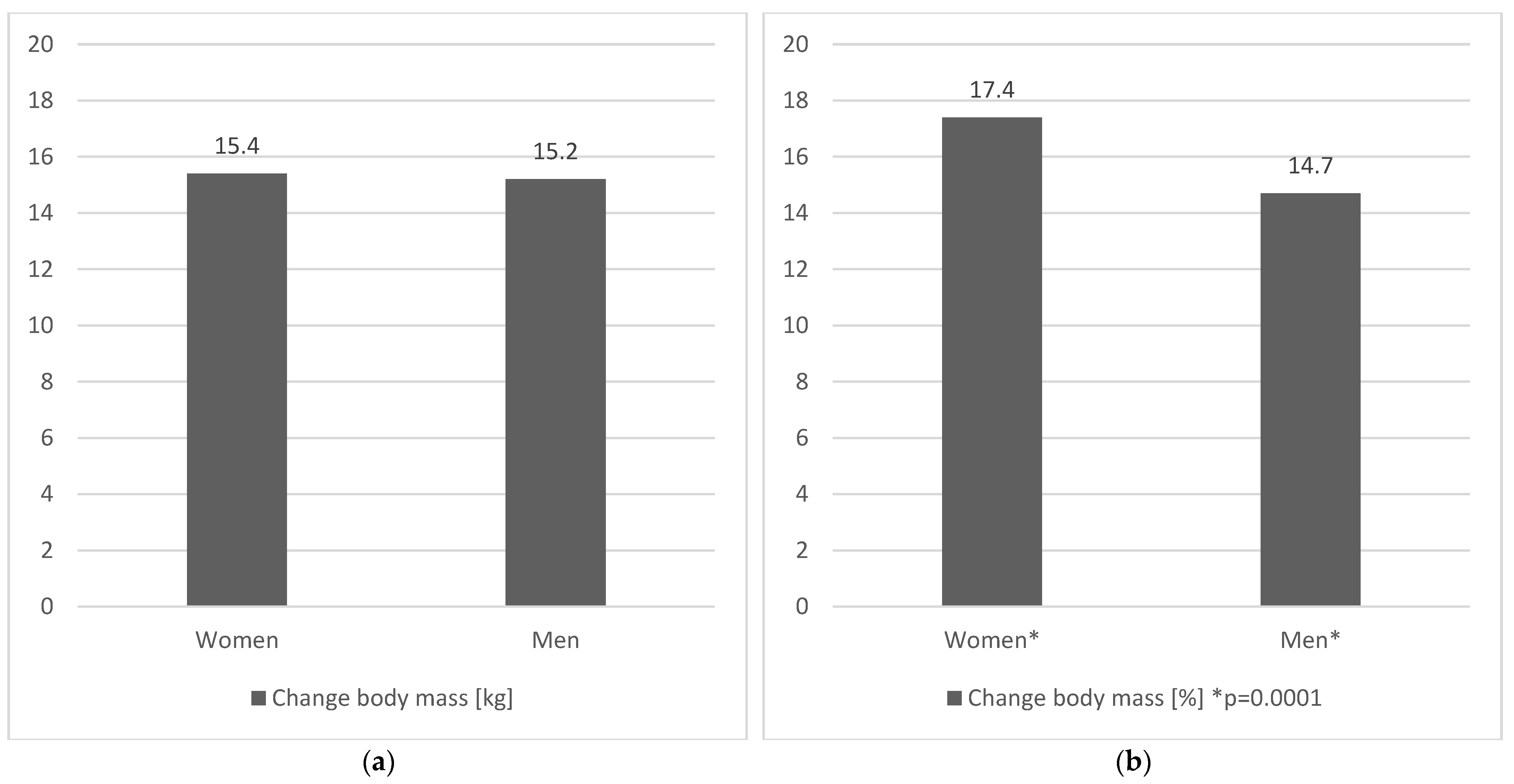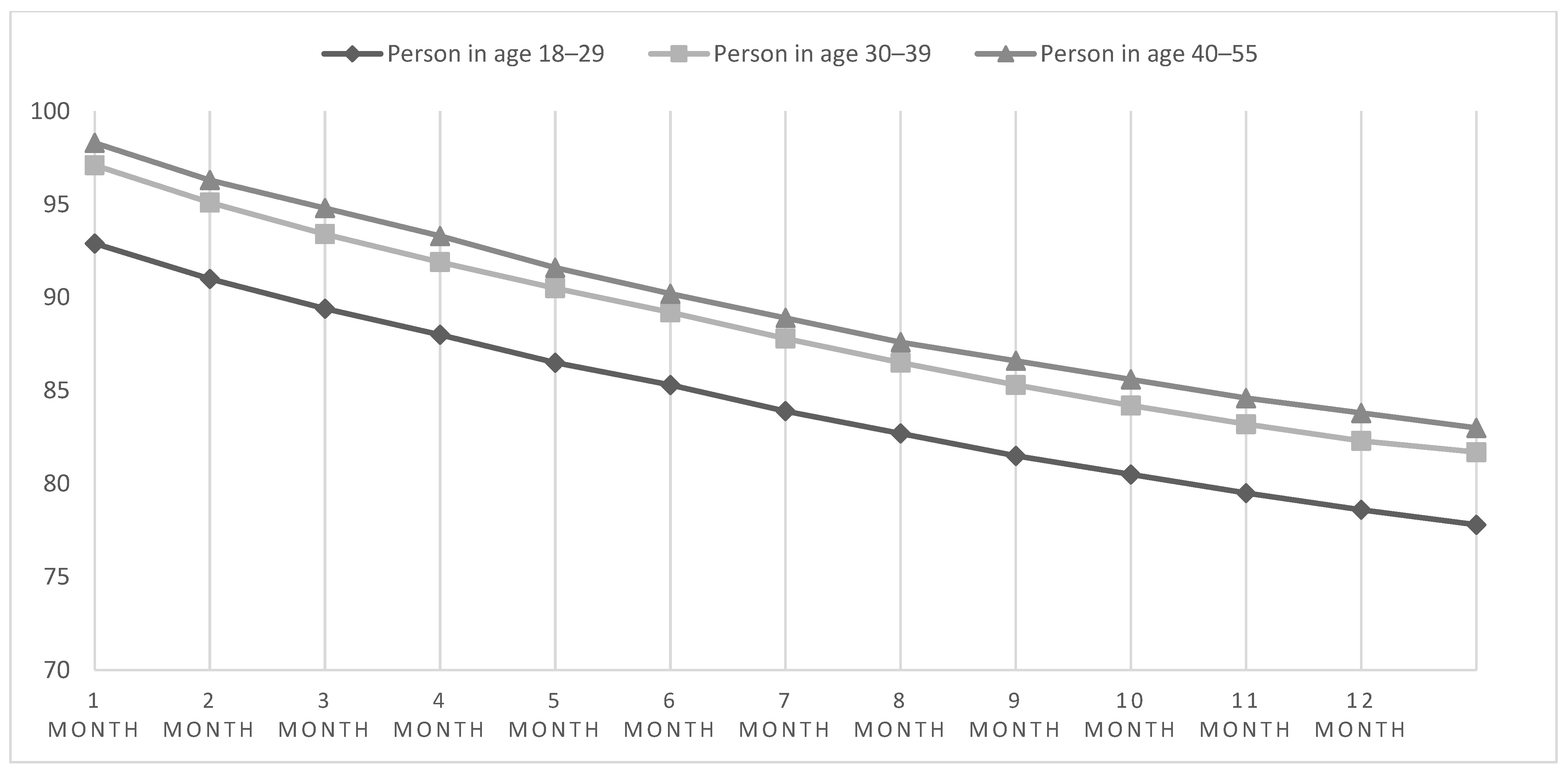Effect of Age and Gender on the Efficacy of a 12-Month Body Weight Reduction Program Conducted Online—A Prospective Cohort Study
Abstract
:1. Introduction
2. Methodology
2.1. Study Design and Purpose
2.2. Sample
2.3. Study Procedure and Intervention Characteristics
2.4. Outcome Measurements
2.5. Statistical Analysis
3. Results
4. Discussion
Limitations of the Study
5. Conclusions
Supplementary Materials
Author Contributions
Funding
Institutional Review Board Statement
Informed Consent Statement
Data Availability Statement
Acknowledgments
Conflicts of Interest
References
- Available online: https://ec.europa.eu/eurostat/web/products-eurostat-news/-/ddn-20210721-2 (accessed on 1 May 2022).
- Available online: https://apps.who.int/iris/bitstream/handle/10665/353747/9789289057738-eng.pdf (accessed on 1 May 2022).
- Available online: https://www.gov.uk/government/publications/health-matters-obesity-and-the-food-environment/health-matters-obesity-and-the-food-environment--2 (accessed on 1 May 2022).
- Popkin, B.M.; Du, S.; Green, W.D.; Beck, M.A.; Algaith, T.; Herbst, C.H.; Alsukait, R.F.; Alluhidan, M.; Alazemi, N.; Shekar, M. Individuals with obesity and COVID-19: A global perspective on the epidemiology and biological relationships. Obes. Rev. 2020, 21, e13128. [Google Scholar] [CrossRef]
- Dicker, D.; Bettini, S.; Farpour-Lambert, N.; Frühbeck, G.; Golan, R.; Goossens, G.; Halford, J.; O’Malley, G.; Mullerova, D.; Ramos Salas, X.; et al. Obesity and COVID-19: The Two Sides of the Coin. Obes. Facts. 2020, 13, 430–438. [Google Scholar] [CrossRef]
- Crane, M.M.; Jeffery, R.W.; Sherwood, N.E. Exploring Gender Differences in a Randomized Trial of Weight Loss Maintenance. Am. J. Mens. Health 2017, 11, 369–375. [Google Scholar] [CrossRef]
- Bhogal, M.S.; Langford, R. Gender differences in weight loss; evidence from a NHS weight management service. Public Health 2014, 128, 811–813. [Google Scholar] [CrossRef]
- Chang, E.; Varghese, M.; Singer, K. Gender and Sex Differences in Adipose Tissue. Curr. Diab. Rep. 2018, 18, 69. [Google Scholar] [CrossRef]
- Haftenberger, M.; Mensink, G.B.; Herzog, B.; Kluttig, A.; Greiser, K.H.; Merz, B.; Nöthlings, U.; Schlesinger, S.; Vogt, S.; Thorand, B.; et al. Changes in body weight and obesity status in German adults: Results of seven population-based prospective studies. Eur. J. Clin. Nutr. 2016, 70, 300–305. [Google Scholar] [CrossRef]
- Zomer, E.; Gurusamy, K.; Leach, R.; Trimmer, C.; Lobstein, T.; Morris, S.; James, W.P.; Finer, N. Interventions that cause weight loss and the impact on cardiovascular risk factors: A systematic review and meta-analysis. Obes. Rev. 2016, 17, 1001–1011. [Google Scholar] [CrossRef]
- Woźniak, J.; Garbacz, K.; Wojciechowska, O.; Wrzosek, M.; Włodarek, D. Effectiveness of a 12-Month Online Weight Reduction Program in Cohorts with Different Baseline BMI—A Prospective Cohort Study. Nutrients 2022, 14, 3281. [Google Scholar] [CrossRef]
- Lewandowicz, M.; Krzymińska-Siemaszko, R.; Wieczorowska-Tobis, K. A review of methods of dietary assessment with the distinction of food photography method with possibility of their use in elderly people. Geriatria 2015, 9, 3–10. Available online: http://www.kierunek-zdrowie.pl/uploads/articles/Lewandowicz%20Przegl%C4%85d%20metod.pdf (accessed on 1 May 2022). (In Polish).
- Jarosz, M. Normy Żywienia dla Populacji Polski. IŻŻ. 2017; pp. 11–311. Available online: https://www.pzh.gov.pl/wp-content/uploads/2020/12/Normy_zywienia_2020web-1.pdf (accessed on 1 May 2022). (In Polish)
- Johansson, G.; Westerterp, K.R. Assessment of the physical activity level with two questions: Validation with doubly labeled water. Int. J. Obes. 2008, 32, 1031–1033. [Google Scholar] [CrossRef]
- Vitale, K.; Getzin, A. Nutrition and Supplement Update for the Endurance Athlete: Review and Recommendations. Nutrients 2019, 11, 1289. [Google Scholar] [CrossRef] [Green Version]
- Pagoto, S.L.; Schneider, K.L.; Oleski, J.L.; Luciani, J.M.; Bodenlos, J.S.; Whited, M.C. Male inclusion in randomized controlledtrials of lifestyle weight loss interventions. Obesity 2012, 20, 1234–1239. [Google Scholar] [CrossRef]
- NWCR Facts [Webpage on the Internet]. National WeightControl Registry. 2014. Available online: http://www.nwcr.ws/Research/default.htm (accessed on 1 May 2022).
- Zhang, L.; Rashad, I. Obesity and time preference: The health consequences of discounting the future. J. Biosoc. Sci. 2008, 40, 97–113. [Google Scholar] [CrossRef]
- McCabe, M.P.; McGreevy, S.J. Role of media and peers on bodychange strategies among adult men: Is body size important? Eur. Eat. Disord. Rev. 2011, 19, 438–446. [Google Scholar]
- Hunt, K.; McCann, C.; Gray, C.M.; Mutrie, N.; Wyke, S. You’ve got towalk before you run’’: Positive evaluations of a walking pro-gram as part of a gender-sensitized, weight-managementprogram delivered to men through professional footballclubs. Health Psychol. 2013, 32, 57–65. [Google Scholar] [CrossRef]
- Wolfe, B.L.; Smith, J.E. Different strokes for different folks:why overweight men do not seek weight loss treatment. Eat. Disord. 2002, 10, 115–124. [Google Scholar] [CrossRef]
- Moroshko, I.; Brennan, L.; O’Brien, P. Predictors of dropout in weight loss interventions: A systematic review of the literature. Obes. Rev. 2011, 12, 912–934. [Google Scholar] [CrossRef]
- Robertson, C.; Avenell, A.; Boachie, C.; Stewart, F.; Archibald, D.; Douglas, F.; Hoddinott, P.; van Teijlingen, E.; Boyers, D. Should weight loss and maintenance programmes be designed differently for men? A systematic review of long-term randomised controlled trials presenting data for men and women: The ROMEO project. Obes. Res. Clin. Pract. 2016, 10, 70–84. [Google Scholar] [CrossRef]
- Sanal, E.; Ardic, F.; Kirac, S. Effects of aerobic or combined aerobic resistance exercise on body composition in overweight and obese adults: Gender differences. A randomized intervention study. Eur. J. Phys. Rehabil. Med. 2013, 49, 1–11. [Google Scholar]
- Gabriele, J.M.; Carpenter, B.D.; Tate, D.F.; Fisher, E.B. Directive and nondirective e-coach support for weight loss in overweight adults. Ann. Behav. Med. 2011, 41, 252–263. [Google Scholar] [CrossRef]
- ter Bogt, N.C.; Bemelmans, W.J.; Beltman, F.W.; Broer, J.; Smit, A.J.; van der Meer, K. Preventing weight gain: One-year results of a randomized lifestyle intervention. Am. J. Prev. Med. 2009, 37, 270–277. [Google Scholar] [CrossRef]
- West, D.S.; Elaine Prewitt, T.; Bursac, Z.; Felix, H.C. Weight loss of black, white, and Hispanic men and women in the Diabetes Prevention Program. Obesity 2008, 16, 1413–1420. [Google Scholar] [CrossRef]
- Donnelly, J.E.; Honas, J.J.; Smith, B.K.; Mayo, M.S.; Gibson, C.A.; Sullivan, D.K.; Lee, J.; Herrmann, S.D.; Lambourne, K.; Washburn, R.A. Aerobic exercise alone results in clinically significant weight loss for men and women: Midwest exercise trial 2. Obesity 2013, 21, E219–E228. [Google Scholar] [CrossRef] [Green Version]


| Variable | Value |
|---|---|
| Caloric value [%] | 85% TDEE |
| Proteins [g/kg body mass] | 1.6 g |
| Fats in total [%] | 25–35% of energy |
| Carbohydrates [%] | 50–55% of energy |
| Fiber [g] | 30–40 |
| Saturated FA [%] | <5% of energy |
| Monosaturated FA [%] | 14–26% of energy |
| Polysaturated FA [%] | 4–6% of energy |
| Variable | The Whole Group n = 400 Women = 210 Men = 190 | |
|---|---|---|
| Mean ± SD | Median (Min-Max) | |
| Age [years] | 33.42 ± 7.2 | 32 (19–55) |
| Height [m] | 1.73 ± 0.09 | 1.73 (1.50–2.02) |
| Body mass [kg] | 95.99 ± 17.01 | 95 (63–156.8) |
| BMI [kg/m2] | 31.83 ± 4.77 | 30.9 (25.1–51.7) |
| BMR [kcal] | 1950.1 ± 342 | 1911 (1323–3108) |
| PAL | 1.49 ± 0.15 | 1.5 (1.2–2.0) |
| TDEE [kcal] | 2883.9 ± 454.1 | 2837 (1984–4603) |
| Variable | Men (n = 190) | Women (n = 210) | p * | ||
|---|---|---|---|---|---|
| Mean ± SD | Median (Min-Max) | Mean ± SD | Median (Min-Max) | ||
| Age [years] | 33.43 ± 6.9 | 32 (19–55) | 34.41 ± 7.45 | 31 (20–55) | 0.48 |
| Height [m] | 1.80 ± 0.07 | 1.80 (1.57–2.02) | 1.67 ± 0.06 | 1.68 (1.5–1.87) | 0.00001 |
| Body mass [kg] | 103.6 ± 16 | 103 (64.8–156.8) | 89.1 ± 14.8 | 87 (63–142) | 0.00001 |
| BMI [kg/m2] | 31.9 ± 4.54 | 30.86 (25.1–48.9) | 31.8 ± 4.98 | 31 (25.2–51.76) | 0.54 |
| BMR [kcal] | 2156 ± 310 | 2147 (1360–3108) | 1763 ± 251 | 1695 (1323–2898) | 0.00001 |
| PAL | 1.48 ± 0.15 | 1.42 (1.2–2.0) | 1.49 ± 0.14 | 1.5 (1.2–2.0) | 0.07 |
| TDEE [kcal] | 3173 ± 410 | 3140 (2230–4603) | 2621 ± 310 | 2592 (1984–3921) | 0.00001 |
| Trainings per week | 3.13 ± 0.82 | 3 (1–7) | 3.31 ± 0.84 | 3 (1–6) | 0.01 |
| Training time [min] | 58.7 ± 17.96 | 60 (30–120) | 55 ± 17.99 | 60 (30–120) | 0.02 |
| Training time per week [min] | 185 ± 81.9 | 180 (90–330) | 181.7 ± 76.7 | 180 (45–430) | 0.59 |
| Variable | Person in Age 18–29 (n = 136) Women = 77 * Men = 59 * | Person in Age 30–39 (n = 156) Women = 75 * Men = 81 * | Person in Age 40–55 (n = 108) Women = 58 * Men = 50 * | p * 0.33 | |||
|---|---|---|---|---|---|---|---|
| Mean ± SD | Median (Min-Max) | Mean ± SD | Median (Min-Max) | Mean ± SD | Median (Min-Max) | p ** | |
| Height [m] | 1.71 ± 0.09 | 1.72 (1.50–1.97) | 1.74 ± 0.09 | 1.74 (1.5–2.02) | 1.74 ± 0.08 | 1.74 (1.52–1.96) | 0.21 |
| Body mass [kg] | 92.9 ± 15.6 a | 90.6 (65–133) | 97.09 ± 17.9 b | 95 (63–156.8) | 98.34 ± 16.9 b | 97.9 (67–142.6) | 0.03 |
| BMI [kg/m2] | 31.17 ± 4.62 | 30.1 (25.1–51.76) | 31.8 ± 4.84 | 30.86 (25.1–49.1) | 32.7 ± 4.77 | 32.1 (25.2–51.4) | 0.06 |
| BMR [kcal] | 1896 ± 313 | 1835 (1365–2793) | 1979 ± 358 | 1953 (1323–3108) | 1975 ± 351 | 1928 (1407–2994) | 0.12 |
| PAL | 1.51 ± 0.14 a | 1.5 (1.3–2.0) | 1.47 ± 0.13 b | 1.4 (1.2–1.9) | 1.47 ± 0.14 b | 1.4 (1.2–2.0) | 0.02 |
| TDEE [kcal] | 2859 ± 437 | 2793 (2029–4199) | 2906 ± 481 | 2891 (1984–4603) | 2882 ± 435 | 2832 (2133–4040) | 0.64 |
| Trainings per week | 3.29 ± 0.86 a | 3 (1–6) | 3.29 ± 0.86 a | 3 (1–7) | 3.03 ± 0.8 b | 3 (1–4) | 0.01 |
| Training time [min] | 56.9 ± 17.7 | 60 (30–120) | 57.1 ± 20.5 | 60 (45–120) | 56.1 ± 14.4 | 60 (30–90) | 0.97 |
| Training time per week [min] | 189.4 ± 85 | 180 (45–400) | 187.3 ± 83.4 | 180 (90–480) | 169.9 ± 62.4 | 180 (60–360) | 0.21 |
Publisher’s Note: MDPI stays neutral with regard to jurisdictional claims in published maps and institutional affiliations. |
© 2022 by the authors. Licensee MDPI, Basel, Switzerland. This article is an open access article distributed under the terms and conditions of the Creative Commons Attribution (CC BY) license (https://creativecommons.org/licenses/by/4.0/).
Share and Cite
Woźniak, J.; Woźniak, K.; Wojciechowska, O.; Wrzosek, M.; Włodarek, D. Effect of Age and Gender on the Efficacy of a 12-Month Body Weight Reduction Program Conducted Online—A Prospective Cohort Study. Int. J. Environ. Res. Public Health 2022, 19, 12009. https://doi.org/10.3390/ijerph191912009
Woźniak J, Woźniak K, Wojciechowska O, Wrzosek M, Włodarek D. Effect of Age and Gender on the Efficacy of a 12-Month Body Weight Reduction Program Conducted Online—A Prospective Cohort Study. International Journal of Environmental Research and Public Health. 2022; 19(19):12009. https://doi.org/10.3390/ijerph191912009
Chicago/Turabian StyleWoźniak, Jakub, Katarzyna Woźniak, Olga Wojciechowska, Michał Wrzosek, and Dariusz Włodarek. 2022. "Effect of Age and Gender on the Efficacy of a 12-Month Body Weight Reduction Program Conducted Online—A Prospective Cohort Study" International Journal of Environmental Research and Public Health 19, no. 19: 12009. https://doi.org/10.3390/ijerph191912009
APA StyleWoźniak, J., Woźniak, K., Wojciechowska, O., Wrzosek, M., & Włodarek, D. (2022). Effect of Age and Gender on the Efficacy of a 12-Month Body Weight Reduction Program Conducted Online—A Prospective Cohort Study. International Journal of Environmental Research and Public Health, 19(19), 12009. https://doi.org/10.3390/ijerph191912009





